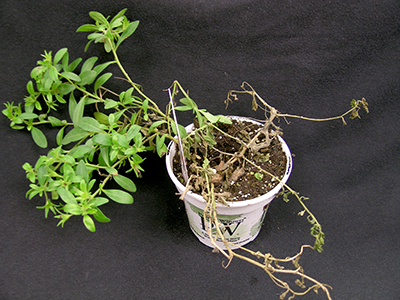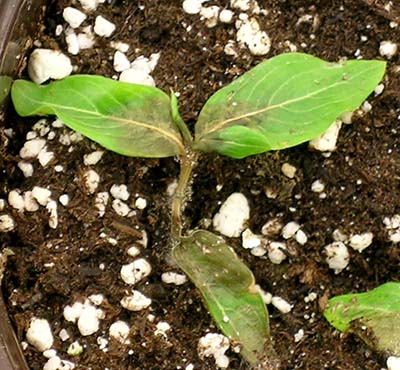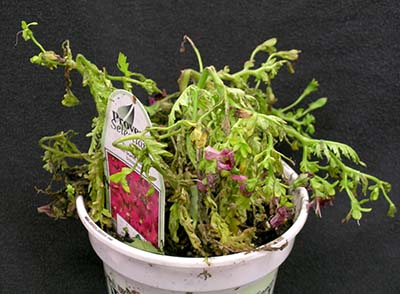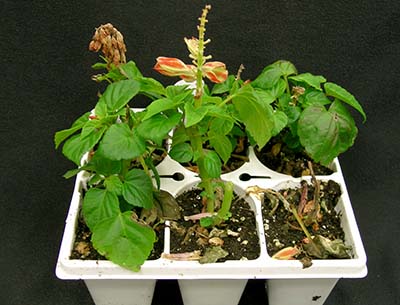R is for Rhizoctonia rot on ornamentals
Know the ABCs of ornamental greenhouse diseases, including Rhizoctonia rot.

The Rhizoctonia solani fungus typically causes a dull brown to dark brown rot on lower plant stems (Photo 1). In severe cases it can also destroy the root system of an infected plant, resulting in wilting and plant death (Photos 2-6). This pathogen can thrive in wet/dry or warm/cool conditions. Sanitation is an important method of limiting the pathogen as it is most likely to spread with contaminated soil and used flats or pots.
Growing mixes that are naturally suppressive to damping-off soilborne fungi are also available to growers. A suppressive medium is one that represses, restrains or checks the growth of damping-off fungi. Initially, interested growers may want to test the usefulness of suppressive media in their growing system by planting a small portion of their crop in suppressive media. Communication with sales representatives and extension personnel may be helpful to evaluate and perhaps modify growing systems using suppressive medium to achieve the best results.
The “A” and “B+” Team tables of fungicides recommended for Rhizoctonia on ornamentals are the result of multiple trials conducted at Michigan State University. The FRAC code is an alphanumeric code assigned by the Fungicide Resistance Action Committee and is based on the mode of action of the active ingredient. When treating for Rhizoctonia rot, rotate among products with different FRAC codes to reduce the possibility of resistance developing in the Rhizoctonia fungus. Ornamental products listed in the A Team table consistently provide effective control. B Team products are a good rotational choice when disease pressure is not severe.
Terraclor, Terraguard, Cleary’s 3336/OHP 6672 and Medallion applied as a drench have been important tools in preventing Rhizoctonia on ornamentals and halting its spread. Biocontrol agents are becoming more widely available for use in controlling damping-off fungi such as Rhizoctonia, and repeated studies with the biopesticide active ingredient polyoxin D zinc salt have shown it to be a very effective product.
|
Rhizoctonia A Team (ornamental recommendations only) | ||
|---|---|---|
|
Product |
Active ingredient |
FRAC code |
|
Affirm WDG |
polyoxin D zinc salt |
19 |
|
Emblem/Medallion WG |
fludioxonil |
12 |
|
Empress Intrinsic |
pyraclostrobin |
11 |
|
Orkestra |
fluxapyroxad/pyraclostrobin |
7/11 |
|
Pageant Intrinsic |
pyraclostrobin/boscalid |
11/7 |
|
Terraclor 400 |
PCNB |
14 |
|
Tourney |
metconazole |
3 |
|
Rhizoctonia B+ Team (ornamental recommendations only) | ||
|---|---|---|
|
Product |
Active ingredient |
FRAC code |
|
Captan |
captan |
M04 |
|
Cleary’s 3336 WP/OHP 6672 FL |
thiophanate-methyl |
1 |
|
Heritage WG |
azoxystrobin |
11 |
Photo. 2. Wilt and plant death of osteospermum infected with Rhizoctonia.

Photo. 3. Wilt of calibrachoa infected with Rhizoctonia.

Photo. 4. Wilt and plant death of vinca infected with Rhizoctonia.

Photo. 5. Wilt of schizanthus infected with Rhizoctonia.

Photo. 6. Wilt and plant death of salvia infected with Rhizoctonia.
Learn more about the ABCs of ornamental greenhouse diseases
- B is for Botrytis blight on ornamentals
- P is for Phytophthora rot on ornamentals
- P is for powdery mildew on ornamentals
- P is for Pythium root rot on ornamentals
- T is for Thielaviopsis root rot on ornamentals
Acknowledgments. This material is based upon work supported by Cooperative Agreement 58-8062-5-036 with USDA ARS under the Floriculture and Nursery Research Initiative.

Dr. Hausbeck’s work is funded in part by MSU’s AgBioResearch.



 Print
Print Email
Email


